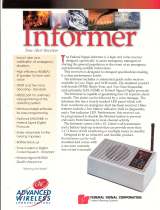You control the TS-2000/2000X/B2000 from the portable Commander (CMD).
Voice is transmitted from the CMD unit on the 440MHz band.
Control signals are also sent from the CMD unit on the 440MHz band.
The HF signal received by the TS-2000/2000X/B2000 is relayed to the CMD unit on the 144MHz band.
You can confirm the HF frequency on the LCD of the CMD.
The TS-2000/2000X/B2000 is fully
equipped for Kenwood’s Skycommand
System II Plus. With just a handheld
transceiver you can relax in your garden
while DX’ing from your shack. Alter-
natively, you could enjoy HF access via
the multibander in your parked car while
taking in a baseball game.
Conventionally two extra transceivers
are required for KSS operation — a
Commander and a Transporter — but the
TS-2000/2000X/B2000 has Transporter
functions built in. This means you can
operate it remotely with a single mobile
or handheld unit, such as the TH-D7A or
TM-D700A, transmitting control signals to
the Transporter, which also relays your
voice to the HF radio. In return, HF
signals are transmitted back to the
Commander. This system allows you to
transmit and receive HF signals, set fre-
quencies (with LCD confirmation), switch
memory channels, and much more — all
remotely.
Kenwood Skycommand System II Plus
Kenwood Skycommand System II Plus is
the most sophisticated version yet devel-
oped, enabling full-duplex operation with
access to such HF functions as RIT/XIT,
mode switching (USB, FM, etc.), split-
frequency operations on/off, and memory
shift. Control is effected via simple TNC,
compatible with the AX.25 protocol. In
addition, if a second TS-2000/2000X/
B2000 unit is used as the Commander,
you have control over noise reduction,
noise blanker on/off and antenna
switching among other functions.
Other Features
Large, amber-colored backlit LCD Backlit front keys
Compatible with optional DRU-3A digital recording unit
Key operation announcement with optional VS-3 voice
synthesizer (option)
Programmable function keys
Transverter (displays up to 19.99999GHz)
RF gain control All-mode squelch Simple visual scan
Auto simplex checker Auto repeater offset (144/1200MHz)
DTMF remote control Built-in keyer
Noise blanker Auto power-off
Enhanced Operating Ease
Automatic Antenna Tuner
The built-in antenna tuner — which also operates when the
radio is in receive mode — covers amateur bands from 1.9
to 50MHz, with
rapid tuning lock
when using presets.
300 Memory Channels
This transceiver provides a bank of 300 memories (plus 1
call channel for each band), with 290 assignable by name
and 10 available for programmable scan. The scroll func-
tion lets you browse memory contents, memory channel
copy sends the contents of one channel to another, lock-out
memory changes the scan map to exclude certain channels,
and memory shift alters the frequency stored in a channel.
In addition, there are 10 ‘quick’ memories to capture a cur-
rent operation on-the-fly — ideal for contest operation.
Multiple Scan Functions
A full range of scan functions is provided, including MHz
scan, memory scan, and call scan. Group scan mode covers
all 300 memory channels in groups of 10, and programma-
ble band scan will search a frequency spread between two
VFO settings (the scan-hold function stops the scanning for
5 seconds). A new feature is programmable slow scan,
which will automatically slow down to check a frequency
range you’re interested in. As well as varying scan speed,
you can choose either time-operated (TO) or carrier-operat-
ed (CO) busy-stop-resume.
Menu System
All of the power and functions of the TS-2000/2000X/
B2000 can be accessed through the menu-driven display
interface on the front panel. You may also activate the Quick
Menu feature to access only your most commonly-used
functions.
Commander (CMD)
TH-D7A or TM-D700A
440MHz/144MHz
TS-2000/2000X/B2000
with built-in Transporter (TRP)
440MHz band
440MHz band
144MHz band
HF Antenna
Voice signals
Control signals
Confirmation of
HF frequency
HF receive audio











